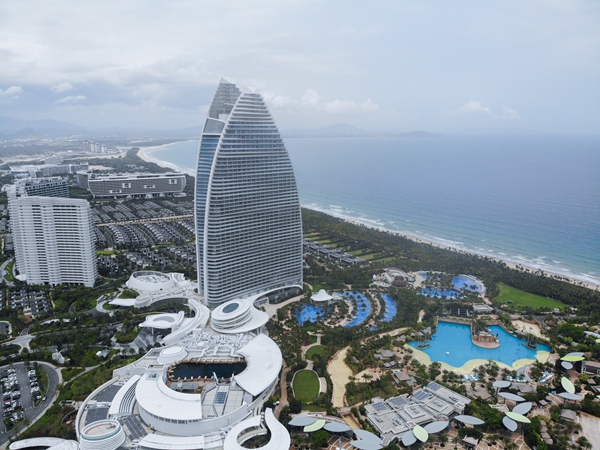Hainan free trade port: A new highland of open economy
 0 Comment(s)
0 Comment(s) Print
Print E-mail Xinhua, June 9, 2020
E-mail Xinhua, June 9, 2020

Hainan, the southern island province of China, has been attracting people from around the globe with its sandy beaches, coconut trees, and year-round sunshine. The island is becoming a hotspot this year due to China's plans to build a free trade port with the highest level of openness.
With a plan aiming at further consolidating the foundation of the real economy and enhancing economic competitiveness, a free trade port system will be "basically established" in Hainan by 2025, becoming "more mature" by 2035, with a focus on the liberalization and facilitation of trade, investment, transport and the flow of talent, capital and data.
Injecting new vitality into enterprises
Market entities will enjoy a batch of benefits in investment, tax and market access when doing business in the Hainan free trade port, said Shen Xiaoming, governor of Hainan, at a press conference Monday.
Streamlined procedures will be available to companies, with license application and government approval not required for industries that are not prohibited by law or mandatory standards.
Foreign investment will be subject to a management system combining pre-establishment national treatment and a negative list designated for the free trade port, further reducing restrictions and prohibitions on the basis of free trade zones, Shen said.
Domestic firms registered in the free trade port will be encouraged to raise funds by issuing shares abroad. The free trade port will also offer tax benefits for firms operating in sectors such as tourism, modern services, and new and high technology by exempting enterprise income tax for the income from their direct investment overseas.
The southern island province will further open the tertiary industry by significantly reducing restrictions on market access. Efforts will be made to deepen opening up in the sectors such as shipping, telecommunication, business services, finance, medical care, education, culture and sports, said Shen.
Enhancing trade liberalization, facilitation
China will support free trade of commodities by granting zero-tariff treatment in an orderly manner and remove non-tariff barriers such as permits and quotas, Vice Commerce Minister Wang Shouwen told a press conference on Monday.
In the first stage, before 2025, certain goods will be exempt from import duties, import value-added tax and consumption tax, while after 2025, import duty exemptions will apply on all imported goods other than those listed in the catalog of imported taxable commodities, said Vice Finance Minister Zou Jiayi.
A pioneering negative list will be formed this year for cross-border service trade at the port to facilitate cross-border delivery, overseas consumption and the flow of people. Cross-border service trade not on the list will be granted free entry into the port.
To bolster consumption in the area, the port will further relax the annual tax-free shopping quota for travelers by raising the limit of purchase from 30,000 yuan (about 4,230 U.S. dollars) to 100,000 yuan per person each year and expanding the categories of duty-free goods, Zou said.
Expanding financial opening-up
The Hainan free trade port will take the lead in expanding the opening-up of the financial service sector, which entails support for setting up trading venues for financial products related to energy, shipping and commodities, said Pan Gongsheng, vice governor of the People's Bank of China.
China will also strengthen financial support to promote the scale of industrial agglomeration and enhance the industrial competitiveness of major industries in Hainan, as well as innovating and developing trade finance, consumer finance, green finance and technology finance.
Financial policies will serve cross-border trade, Pan said, adding that the capital exchange for trade in goods and services should be highly facilitated, and the policies regulating new trade patterns, such as offshore trade and entrepot trade, should be improved.
Supplementing rather than replacing Hong Kong
Concerns that the Hainan free trade port will undermine Hong Kong's status as a global financial, trading and shipping center were dismissed Monday by Lin Nianxiu, deputy director of the National Development and Reform Commission.
With different orientations and priority industries, Hainan and Hong Kong are more complementary than competitive, Lin said at a press conference.
The country will work to promote the joint development of Hainan and the Guangdong-Hong Kong-Macao Greater Bay Area and ensure Hong Kong's long-term prosperity and stability, Lin noted.
Sticking to environmentally-friendly development
The free trade port greatly stresses environmental protection in the process of its development, strictly restricting real estate expansion, said Liu Cigui, Party chief of Hainan, citing the importance of building a diversified modern industrial system with limited land resources.
The province has also made efforts to achieve the air-quality goal for 2030, such as using clean energy. Sales of oil-fueled automobiles will be banned starting 2030, and the use of non-biodegradable plastic products will be prohibited from the end of 2020, Liu said, adding that the Hainan free trade port welcomes investors and talents all over the world to share the opportunity of China's development and the fruits of China's reform and opening-up.






Go to Forum >>0 Comment(s)